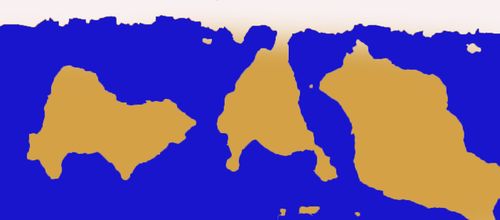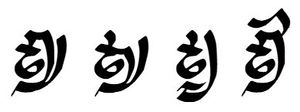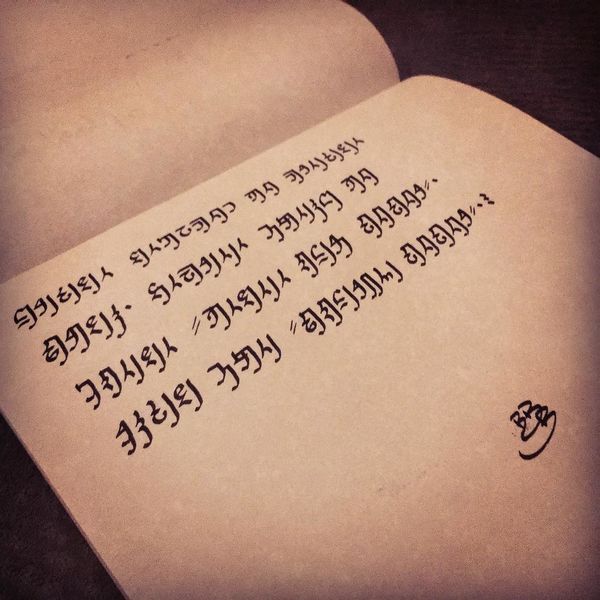Lortho
| Lortho ['loɾ.tʰo] | |
| Spoken in: | Lamona Continent |
| Conworld: | Dhamashi, a circumbinary planet |
| Total Speakers: | ~ 60,000,000 |
| Genealogical classification: | Old Lortho - Lortho - ? |
| Basic word order: | Verb-Subject-Object |
| Morphological Type: | Agglutinating |
| Morphosyntactic Alignment: | Nominative-Accusative |
| Created by: | |
| Brian Bourque | March 2017 |
Introduction
Lortho (IPA:[ˈloɾ·tʰo]) is an a priori constructed language created by Brian Bourque in the beginning of 2003. It originally started as a prop for a strategy board game where only the script was created for aesthetics. Fast forward about 13 years and it has now evolved into a agglutinating language with some minor fusional aspects. The verbs and nouns are modified with affixes.
Inspiration
A friend was creating a board game similar to Risk; however, instead of taking place on Earth, this new game was to take place on an inter-planetary scale. The game creator wanted to develop an extraterrestrial theme and requested a fictional script. The name of the race on this game is "Lortho" and thus the seed was planted. Brian was unable to work on this piece for quite sometime until he joined the CONLANG mailing list and observed both seasoned and novice conlangers discussing all aspects of linguistics. Since then he decided to move forward and bring Lortho into fruition.
Another inspirational source is Brian's daughter. Through her development of learning how to make speech sounds leading to coherent speech, Brian found certain "words" to use in Lortho which he used to develop its phonology.
Setting
Section under development Please do not edit this section while this banner is displayed
The people (Kalanune) who speak Lortho live on a circumbinary plant which has two natural satellites in an alternate universe. The planet's surface has many similarities to Earth where it has oceans, mountains, deserts, and forests. The planet has three major continents: Mashonu, Kashti, and Lamona. The Kalanune live on Lamona.
Even though there are two stars, neither one can be seen separate from one another during daylight hours. At dawn and dusk, however, both can bee seen due to light refraction through the world's atmosphere.

| ||
| Kashti | Lamona | Mashonu |
| Dhamashi | ||
Etymology of Lortho
Lortho is a combination of Lor, the god from which their story of life stems, and -tho, the archaic form for the genitive case. It has since become a noun and can take other case endings (e.g. konpharin lorthome - I speak Lortho-ACC).
The mountain from which Lor is said to originate is called Malhi Dharakhi, "Great Mountain," and is located in the coastal mountain range on the west side of Lamona.
Goals
The goal is to create the gradual progression of Lortho which will lead to the development of daughter languages and, eventually, create sister languages which have developed on different parts of the planet.
Phonology
Consonant Inventory
There are 20 consonants in Lortho and all are strictly pronounced the same regardless of placement.
| Bilabial | Labiodental | Alveolar | Postalveolar | Velar | Glottal | |||||||
|---|---|---|---|---|---|---|---|---|---|---|---|---|
| Plosive | p pʰ | b | t tʰ | d dʰ | k kʰ | |||||||
| Nasal | m mː | n nː | ||||||||||
| Tap or Flap | ɾ | |||||||||||
| Fricative | f | s | ʃ | h | ||||||||
| Lateral Approximant | l lʰ | |||||||||||
Vowels
Monophthongs
There are five vowels in Lortho and are strictly pronounced regardless of placement:
| Front | Near-front | Central | Near-back | Back | |
| Close | |||||
| Near‑close | |||||
| Close‑mid | |||||
| Mid | |||||
| Open‑mid | |||||
| Near‑open | |||||
| Open | |||||
Diphthongs
There are only four diphthongs in Lortho; one of which is a ligature:

|
| Lortho diphthongs |
Phonotactics
Syllable Structure
The syllable structure is (C)V(V)(C).
Consonant Clusters
There are no consonant clusters allowed in onsets or codas; however, clusters formed from adjacent syllables (i.e. coda + onset) are allowed. These clusters are:
- /nd/
- /nk/ (normally pronounced [ŋk])
- /np/ (colloquially it is sometimes pronounced [mp] e.g. the verb konpharo to speak)
- /ns/
- /pt/
- /rt/
- /sk/
Prosody
Stress
Stress in Lortho is handled as follows:
- Stress is always on the second to the last syllable of the root or infinitive except:
- -n verbs will always receive stress on the last syllable of the infinitive or root.
- If the word is only two syllables long, then the stress is on the first syllable.
- Stress is never given to prefixes or suffixes, except
- Pluralized nouns will move the stress to the second to the last syllable
Intonation
Section under Development Please do not edit this section while this banner is displayed For general information on intonation (linguistics), please click here
Romanized Text
Since Lortho has its own script, a Romanized version has been set up to make it easy to read and pronounce as shown in the tables below. From here throughout the rest of this page, the romanized version will be used.
| Consonants | ||||||||||||||||||||
| IPA | dʰ | d | kʰ | k | lʰ | l | tʰ | t | pʰ | p | ʃ | s | n | nː | m | mː | h | b | f | ɾ |
| Romanization | dh | d | kh | k | lh | l | th | t | ph | p | sh | s | n | nn | m | mm | h | b | f | r |
| Monophthongs | |||||
| IPA | i | ɑ | ɛ | u | o |
| Romanization | i | a | e | u | o |
| Diphthongs | ||||
| IPA | aɪ | aʊ | ɔɪ | eɪ |
| Romanization | ai | au | oi | ei |
Morphology
Nouns
Gender
Nouns in Lortho have three distinct features:
- They are one of three genders: masculine, feminine, or neuter
- All nouns are modified to denote case
- All nouns end in a vowel
| Masculine | Feminine | Neuter |
|---|---|---|
| -i dharakhi mountain |
-u dhammu chair |
-a hadikha country, land |
Exceptions:
There there are a couple nouns that do not follow the above rules for gender (this will increase as Lortho's lexicon grows):
| Masculine | Feminine | Neuter |
|---|---|---|
| tapas pasta |
dhi water |
Grammatical Case
Lortho has ten cases. The vowels in parentheses are added if the word ends in a consonant.
| Case | Affix | Example | Translation |
|---|---|---|---|
| Nominative | - | kansaptha | woods, forest |
| Accusative | -(i)me | kansapthame | forest (direct obj.) |
| Dative | -(i)mela | kansapthamela | forest (indirect obj.) |
| Genitive | -(i)nalo | kansapthanalo | of the forest |
| Sublative | -ina/-ena | kansaptaina | in/into the forest |
| Ablative | -(e)nat | kansapthanat | out of/from the forest |
| Allative | -(e)dan | kansapthadan | to/towards the forest |
| Prolative | -(e)danar | kansapthadanar | through/via/by way of the forest |
| Instructive | -(i)len | kansapthalen | using the forest |
| Vocative | fa(l)- | fakansaptha | Hey, Food! |
Personal Possessive
The personal possessive is formed using a prefix which is gender and number specific. We will use the following word:
- dhammu n. fem. chair; plural dhammune
| Person | Singular | Plural | ||||
|---|---|---|---|---|---|---|
| masculine | feminine | neuter | masculine | feminine | neuter | |
| 1st person | nidhammu | nudhammu | - | nimadhammu | numadhammu | - |
| 2nd person | lindhammu | lundhammu | - | nanidhammu | nanudhammu | - |
| 3rd person | lidhammu | ludhammu | ladhammu | limidhammu | limudhammu | limadhammu |
Pluralization
Each noun is pluralized by adding a suffix:
- Feminine nouns (-u): simply add the plural ending -ne.
- Example: kansaphu (n. fem) tree; pl kansaphune
- Masculine nouns (-i): subtract the -i and add the plural ending -eni except :
- Masculine noun roots that end in -n, the plural ending will be changed to -emi.
- Examples:
- olakhi (n. masc) boat; pl olakheni
- phorenni (n. masc) peak, summit; pl phoɾennemi
- Neuter nouns (-a): simply add the plural ending -ne (many neuter nouns are collective nouns such as hammuna weather)
- Example: hadikha (n. neut) land, country; pl hadikhane
Verbs
Introduction
Verbs are conjugated in gender and in number which are governed by the subject (written or implied). For the most part the conjugations are simple and are formed through agglutination; however, there are slight fusional changes that occur when denoting aspect.
Conjugation
Regular Verbs
There are three main verbs in Lortho: -o verbs, -t verbs, and -n verbs. The conjugation tables below show a preview of how the regular verbs conjugate in each category. Conjugation in other tenses includes more fusional aspects.
-o verbs
The root is formed by subtracting the final "o."
| Present Tense | ||||||
|---|---|---|---|---|---|---|
| konpharo [kon.'pʰɑ.ɾo] to speak root: konphar- | ||||||
| Singular | Plural | |||||
| masc | fem | neut | masc | fem | neut | |
| 1st pers | konpharin | konpharun | - | konpharinan | konpharunan | - |
| 2nd pers | konpharanni | konpharannu | - | konpharamin | konpharamun | - |
| 3rd pers | konphari | konpharu | konphara | konpharimi | konpharimu | konpharima |
-t verbs
The root is formed by changing the final "t" to a "d."
| Present Tense | ||||||
|---|---|---|---|---|---|---|
| phramit ['pʰɾɑ.mit] to push root: phramid- | ||||||
| Singular | Plural | |||||
| masc | fem | neut | masc | fem | neut | |
| 1st pers | phramidin | phramidun | - | phramidinan | phramidunan | - |
| 2nd pers | phramidanni | phramidannu | - | phramidamin | phramidamun | - |
| 3rd pers | phramidi | phramidu | phramida | phramidimi | phramidimu | phramidima |
-n verbs
The root is the same as the infinitive.
| Present Tense | ||||||
|---|---|---|---|---|---|---|
| shailan [ʃaɪ.'lɑn] to sit root: shailan- | ||||||
| Singular | Plural | |||||
| masc | fem | neut | masc | fem | neut | |
| 1st pers | shailanin | shailanun | - | shailaninan | shailanunan | - |
| 2nd pers | shailananni | shailanannu | - | shailanamin | shailanamun | - |
| 3rd pers | shailani | shailanu | shailana | shailanimi | shailanimu | shailanima |
Irregular Verbs
Although labelled irregular, the verbs still have a regular feel in that they still use the same personal endings; however, the root is derived slightly differently. One example is the verb harlan.
| Present Tense | ||||||
|---|---|---|---|---|---|---|
| harlan [hɑɾ.'lɑn] to be root: harl- | ||||||
| Singular | Plural | |||||
| masc | fem | neut | masc | fem | neut | |
| 1st pers | harlin | harlun | - | harlinan | harlunan | - |
| 2nd pers | harlanni | harlannu | - | harlamin | harlamun | - |
| 3rd pers | harli | harlu | harla | harlimi | harlimu | harlima |
Imperative
The imperative form of the verb is simply the root with the vocative case (which can be either implied or explicit).
Examples:
- famannu, konphar!
- Hey you, speak!
- fanamin, nathar namineme!
- Hey you, be quiet! (lit. quiet yourselves)
- fabrian, shailan!
- Brian, sit!
Vocabulary:
- konpharo (konphar-) v. to speak
- natharo (nathar-) v. to quell, pacify
- mannu pronoun you (fem. sing.)
- namin pronoun you (masc. pl.)
- shailan (shailan-) v. to sit
Adjectives
Adjectives behave a little differently from other words in that they:
- must be placed in front of the noun which they modify
- must agree in gender, but not in number or grammatical case
Syntax
Morphosyntactic Alignment
The morphosyntactic alignment of Lortho is Nominative - Accusative.
Word Order
Verb-Subject-Object (VSO). Lortho contains a lot of information in the verb and the noun or noun phrase. The verb is conjugated by person and gender and thus pronouns are largely unnecessary except for emphasis or clarification. The nouns are altered to denote case, removing almost entirely the need for prepositions.
Word Agreement
There are four basic rules which govern agreement between words:
- Verbs must agree in gender and number with the subject (explicit or implied)
- Cardinal numbers do not take case nor gender
- Nouns are not pluralized when counted
kilikh-in kansaphu-ne-mesee -1MSG.PRS tree.F -PL-ACC
I see treeskilikh-in bon kansaphu-mesee -1MSG.PRS two tree.F -ACC
I see two trees (lit: I see two tree)
- Adjectives must agree with the noun which they modify in gender, but not in grammatical case nor number
Example texts

| |
| Text | Translation |
| konpharin lorthome | I speak Lortho |

| |
| Text | Translation |
| kalanune denimanimu kalanune khonaminalo hana tomidikhimu ma kansapthaina |
The people are known as people of the lanterns and they lived in that forest. |

| |
| Text | Translation |
| lharidikhin kansapthanat hana tharnidikhin dharakhime. konpharinin toshanimela hana semanikhin, "hankhanin malhiro danadanar." remedikhi toshani, "dhamalhirianni danadanar." |
I ran out of the forest and climbed the mountain. I was speaking to the dragon and said, "I want to walk through here." The dragon replied, "You will not walk through here." |
| Source: Brian's Instagram post | |
Resources
Linguistics
Endangered Alphabets - YouTube channel about 14 of the world's writing systems threatened with extinction
International Phonetic Alphabet
Glossika Phonics - YouTube channel for IPA pronunciation
NativLang - YouTube channel about the history of written and spoken language
Omniglot
Online Etymology Dictionary (English)
Reddit: Linguistics
Wikitongues - A not for profit YouTube project to help preserve the world's living languages
World Atlas of Language Structures (WALS)
Constructed Languages
Conlang Atlas of Language Structures (CALS)
Conlang Bulletin Board (CBB)
Conlang Critic - A YouTube vlogger who offers insight on conlangs
Conlang Mailing List
Conlang Relay Museum on CALS
Conlanging on Wikibooks
ConWorkShop - an online one-stop-shop for cataloging your conlang
Fiat Lingua - an online archive of conlang articles
Guide: Writing System - A guide on how to develop your own writing system
Language Creation Society (LCS)
LCS on YouTube
Reddit: Conlangs
Reddit: Neography (Constructed Scripts)
Speculative Grammarian - A satirical periodical on linguistics and conlangery
Zompist Bulletin Board (ZBB)
Lortho
Lortho on CALS
Lortho in the 24th Conlang Relay (8th Position)
Lortho on ConWorkShop
Lortho on FrathWiki
Lortho Lexicon
Miscellaneous
Sajem Tan (Common Honey) Collaborative Conlang Discord Server
